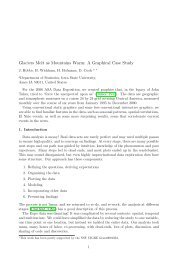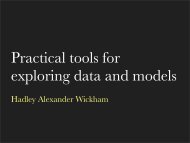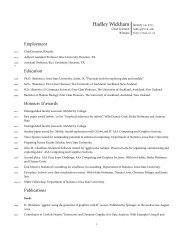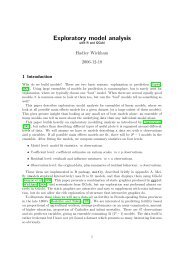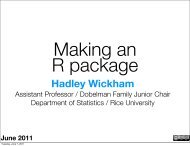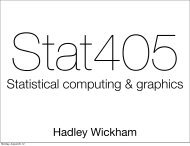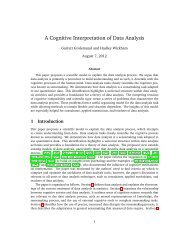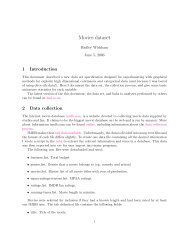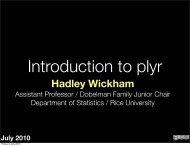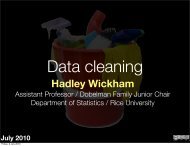Statistical inference for exploratory data analysis ... - Hadley Wickham
Statistical inference for exploratory data analysis ... - Hadley Wickham
Statistical inference for exploratory data analysis ... - Hadley Wickham
Create successful ePaper yourself
Turn your PDF publications into a flip-book with our unique Google optimized e-Paper software.
4380 A. Buja et al.<br />
or detrimental to the process of assessing significance and exploring <strong>data</strong>. If a<br />
pronounced feature is present in the null <strong>data</strong>, readers may be distracted from<br />
the feature of interest. However, in some cases, the readers may report a different<br />
feature in the real <strong>data</strong> than the analyst had noticed, thus leading to discovery<br />
of new in<strong>for</strong>mation about the <strong>data</strong>.<br />
Aside: An alternative approach to graphical <strong>inference</strong>, to assess the significance<br />
of the difference between smoothers, is to produce ‘null bands’ based on<br />
permutations of the race labels (Atkinson 1981; Bowman & Azzalini 1997; Buja &<br />
Rolke 2009). The race labels of the subjects are permuted many times and a<br />
smoother is fitted to each of the resulting samples. These different smooths<br />
are combined to produce an envelope <strong>for</strong> the smoother of the actual <strong>data</strong>,<br />
produced under the assumption that there is no difference between the races.<br />
If we did this <strong>for</strong> these <strong>data</strong>, we would find that <strong>for</strong> Whites and Hispanics the<br />
fit stays within the null bands, but <strong>for</strong> Blacks the actual fit dips low, out of<br />
the limits between experience values 6–10, suggesting that there is something<br />
different about the wage experience <strong>for</strong> this group. The benefit of the graphical<br />
<strong>inference</strong> approach over the null bands approach is that the entire curve from<br />
each permutation is examined, so that curve to curve variation can be seen.<br />
Davison & Hinkley (1997) and Pardoe (2001) have an intermediate solution<br />
between the null band and graphical <strong>inference</strong>, in which the curves are overlaid on<br />
the one plot.<br />
7. Conclusions and caveats and future investigations<br />
This paper proposes two protocols to <strong>for</strong>malize the process of visual discovery,<br />
the Rorschach and lineup. Each helps to quantify the strength of signal versus<br />
noise, similar to numerical hypothesis testing. The Rorschach protocol provides<br />
a prior-to-<strong>analysis</strong> visual calibration training <strong>for</strong> the <strong>data</strong> analyst, and the lineup<br />
provides an inferentially valid test of whether what we see in a plot is really<br />
there. Here are some of the issues that need consideration be<strong>for</strong>e more general<br />
implementation.<br />
(i) The wording of the instructions to viewers can affect their plot choices.<br />
(This is a familiar issue in survey design (Dawes 2000).) Additional<br />
in<strong>for</strong>mation might be included to help viewers make wise choices. For<br />
example, the introduction to the wages <strong>data</strong> example guided viewers<br />
towards the higher <strong>data</strong> density area in the middle of the x range.<br />
The purpose was to pre-empt the naive choice of selecting the plot<br />
exhibiting the strongest end-effects of the smoothed lines, which a trained<br />
statistician would probably avoid. Should this methodological effect factor<br />
into the family-wise Type I error rate? In the other direction, how<br />
much personal baggage is brought to the problem by in<strong>for</strong>ming the<br />
viewer about the nature of the demographic subsets being based on<br />
race? Would it be better to mask the race variable, and call them<br />
groups 1, 2, 3?<br />
(ii) Ancillary in<strong>for</strong>mation related to the viewer’s response will be useful. For<br />
example, the time that an individual takes to arrive at a choice might be<br />
included in the <strong>analysis</strong> of the results. When the choice comes quickly, it<br />
Phil. Trans. R. Soc. A (2009)<br />
Downloaded from<br />
rsta.royalsocietypublishing.org on January 7, 2010



